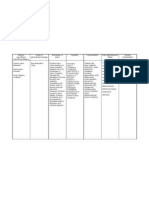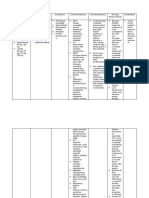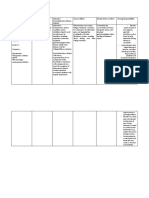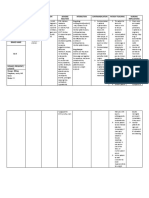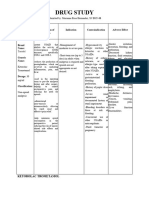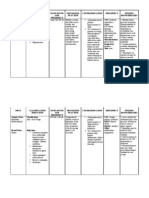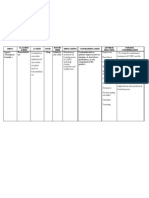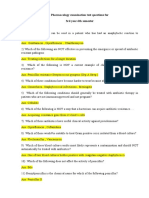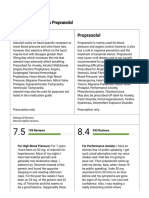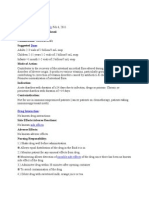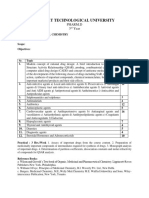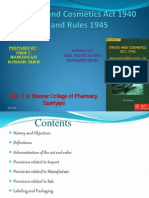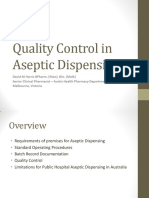0 ratings0% found this document useful (0 votes)
84 viewsDRUG Celecoxib
DRUG Celecoxib
Uploaded by
rholiboiCelecoxib is an anti-inflammatory and analgesic drug used to treat acute pain and primary dysmenorrhea. It works by selectively inhibiting prostaglandin synthesis through inhibition of cyclooxygenase-2 (COX-2). It is contraindicated in patients with hypersensitivity to the drug or other NSAIDs, those with severe hepatic impairment, and for postoperative pain after coronary artery bypass graft surgery. Common side effects include dizziness, headache, insomnia, abdominal pain, diarrhea, dyspepsia, flatulence, and nausea. Nursing considerations include monitoring for signs of bleeding, fluid retention, liver toxicity, and cardiovascular risk factors.
Copyright:
Attribution Non-Commercial (BY-NC)
Available Formats
Download as DOC, PDF, TXT or read online from Scribd
DRUG Celecoxib
DRUG Celecoxib
Uploaded by
rholiboi0 ratings0% found this document useful (0 votes)
84 views2 pagesCelecoxib is an anti-inflammatory and analgesic drug used to treat acute pain and primary dysmenorrhea. It works by selectively inhibiting prostaglandin synthesis through inhibition of cyclooxygenase-2 (COX-2). It is contraindicated in patients with hypersensitivity to the drug or other NSAIDs, those with severe hepatic impairment, and for postoperative pain after coronary artery bypass graft surgery. Common side effects include dizziness, headache, insomnia, abdominal pain, diarrhea, dyspepsia, flatulence, and nausea. Nursing considerations include monitoring for signs of bleeding, fluid retention, liver toxicity, and cardiovascular risk factors.
Copyright
© Attribution Non-Commercial (BY-NC)
Available Formats
DOC, PDF, TXT or read online from Scribd
Share this document
Did you find this document useful?
Is this content inappropriate?
Celecoxib is an anti-inflammatory and analgesic drug used to treat acute pain and primary dysmenorrhea. It works by selectively inhibiting prostaglandin synthesis through inhibition of cyclooxygenase-2 (COX-2). It is contraindicated in patients with hypersensitivity to the drug or other NSAIDs, those with severe hepatic impairment, and for postoperative pain after coronary artery bypass graft surgery. Common side effects include dizziness, headache, insomnia, abdominal pain, diarrhea, dyspepsia, flatulence, and nausea. Nursing considerations include monitoring for signs of bleeding, fluid retention, liver toxicity, and cardiovascular risk factors.
Copyright:
Attribution Non-Commercial (BY-NC)
Available Formats
Download as DOC, PDF, TXT or read online from Scribd
Download as doc, pdf, or txt
0 ratings0% found this document useful (0 votes)
84 views2 pagesDRUG Celecoxib
DRUG Celecoxib
Uploaded by
rholiboiCelecoxib is an anti-inflammatory and analgesic drug used to treat acute pain and primary dysmenorrhea. It works by selectively inhibiting prostaglandin synthesis through inhibition of cyclooxygenase-2 (COX-2). It is contraindicated in patients with hypersensitivity to the drug or other NSAIDs, those with severe hepatic impairment, and for postoperative pain after coronary artery bypass graft surgery. Common side effects include dizziness, headache, insomnia, abdominal pain, diarrhea, dyspepsia, flatulence, and nausea. Nursing considerations include monitoring for signs of bleeding, fluid retention, liver toxicity, and cardiovascular risk factors.
Copyright:
Attribution Non-Commercial (BY-NC)
Available Formats
Download as DOC, PDF, TXT or read online from Scribd
Download as doc, pdf, or txt
You are on page 1of 2
CLASSIFIC ROUTE/ CONTRAINDICATIO NURSING
DRUG ACTION DOSE INDICATIONS SIDE EFFECTS
ATION TIME N CONSIDERATION
Celecoxib Anti- Thought 200mg Per Acute pain and Contraindicated in Dizziness -Watch for signs and
(Celebrex) inflamatory, to inhibit orem/every primary patients hypersensitive symptoms of overt and occult
Analgesic prostaglan 12 hours dysmenorrhea to drug, sulfonamides, Headache bleeding.
din aspirin, or other
synthesis, NSAIDs. Insomnia -Drug can cause fluid
impeding retention; monitor patient with
cyclooxyg Contraindicated in Abdominal hypertension, edema, or heart
enase-2 those with severe pain, failure.
(COX-2), hepatic impairment
to produce and in the treatment of diarrhea -Assess patient for CV risk
anti- preoperative pain after factors before therapy.
inflammat coronary artery bypass dyspepsia,
ory, graft surgery. -Watch for signs and
analgesic, flatulence symptoms of liver toxicity.
and
antipyretic nausea -Before starting drug therapy,
effects. dehydrated patient.
Drug can be given without
regard to meals, but food may
decrease GI upset.
You might also like
- Name of Drug Dosage, Route, Freq., Timing Mech. of Action Indication Adverse Reactions Special Precautions Nursing ResponsibilitiesDocument3 pagesName of Drug Dosage, Route, Freq., Timing Mech. of Action Indication Adverse Reactions Special Precautions Nursing ResponsibilitiesKristine YoungNo ratings yet
- Drug Card Motrin 800mgDocument2 pagesDrug Card Motrin 800mgAdrianne BazoNo ratings yet
- MEBEVERINE Drug StudyDocument4 pagesMEBEVERINE Drug StudyNiziu BearsNo ratings yet
- Generic Name: Mebeverine Hydrochloride Mechanism of Action Side Effects/ Adverse Reaction Nursing Responsibility Assessment & Drug EffectsDocument4 pagesGeneric Name: Mebeverine Hydrochloride Mechanism of Action Side Effects/ Adverse Reaction Nursing Responsibility Assessment & Drug EffectsNiziu BearsNo ratings yet
- Name of Drug Classification and Mode of Action Adverse Effects/precautions Nursing ConsiderationsDocument3 pagesName of Drug Classification and Mode of Action Adverse Effects/precautions Nursing ConsiderationsDyanne BautistaNo ratings yet
- Azathioprine - Frequent:: Anti-Inflammatory Immunosuppressive That Can Decrease Joint Damage and DisabilityDocument3 pagesAzathioprine - Frequent:: Anti-Inflammatory Immunosuppressive That Can Decrease Joint Damage and DisabilityJordz PlaciNo ratings yet
- IX. Drug StudyDocument4 pagesIX. Drug StudykingpinNo ratings yet
- Drug Ana LaraDocument2 pagesDrug Ana LaralarapaulineNo ratings yet
- Drug StudyDocument12 pagesDrug StudyshaztamendozaNo ratings yet
- DS (Ibuprofen)Document6 pagesDS (Ibuprofen)Mary April MendezNo ratings yet
- Final Drug StudyDocument4 pagesFinal Drug StudyBasema HashhashNo ratings yet
- CNS: Headache, InsomniaDocument5 pagesCNS: Headache, InsomniaDave FagaritaNo ratings yet
- OlanzapineDocument3 pagesOlanzapineLeris Luigi VictorioNo ratings yet
- Diclofenalac Sodium (Fenac)Document3 pagesDiclofenalac Sodium (Fenac)karenmichellelecarozNo ratings yet
- Drugstudy JRODDocument4 pagesDrugstudy JRODPeyjeyNo ratings yet
- DRUGSDocument5 pagesDRUGSDanica EspejoNo ratings yet
- Drugs 2Document6 pagesDrugs 2Elyse Ann ReyesNo ratings yet
- Drug Study (V.luna)Document4 pagesDrug Study (V.luna)carizzajoyNo ratings yet
- Drug Study (Med Ward Week 2)Document2 pagesDrug Study (Med Ward Week 2)Kimberly Abellar LatoNo ratings yet
- Drug Study and NCPDocument9 pagesDrug Study and NCPDan Dan ManaoisNo ratings yet
- Drug Study AlzheimersDocument12 pagesDrug Study Alzheimersella retizaNo ratings yet
- Drug StudyDocument2 pagesDrug StudyTrexie ScattNo ratings yet
- Drug StudyDocument4 pagesDrug Studylilac_jasminNo ratings yet
- OMEPRAZOLEDocument2 pagesOMEPRAZOLERea LynNo ratings yet
- DS PantoprazoleDocument2 pagesDS PantoprazoleMatt Reyes Del CastilloNo ratings yet
- Drug StudyDocument4 pagesDrug StudyGerome ManantanNo ratings yet
- Name of DrugDocument3 pagesName of DrugJohn Michael M. RosalesNo ratings yet
- Celecoxib CelebrexDocument1 pageCelecoxib CelebrexBeverly Ann de LeonNo ratings yet
- NCP and Drug StudyDocument9 pagesNCP and Drug StudyJHoy JhoyThotNo ratings yet
- Drug Study IbuprofenDocument3 pagesDrug Study IbuprofenblaireNo ratings yet
- Generic Name Indication (S) Action Adverse Reaction Interaction Contraindication Patient Teaching Nursing ImplicationsDocument2 pagesGeneric Name Indication (S) Action Adverse Reaction Interaction Contraindication Patient Teaching Nursing ImplicationsJake Yvan DizonNo ratings yet
- Amihan - Sec6 - Drug StudyDocument1 pageAmihan - Sec6 - Drug StudyAshley AmihanNo ratings yet
- DS DR RodasDocument7 pagesDS DR RodasChristian MarquezNo ratings yet
- Drug Study ArcoxiaDocument6 pagesDrug Study ArcoxiaSeanmarie CabralesNo ratings yet
- Drug Study Hernandez 2nd SemDocument3 pagesDrug Study Hernandez 2nd SemhernandezmarianneroseNo ratings yet
- Drug StudyDocument1 pageDrug Study049851No ratings yet
- Tramadol Drug Study PDFDocument3 pagesTramadol Drug Study PDFMa. Eloisa YrogirogNo ratings yet
- Drugstudy PatagueDocument4 pagesDrugstudy PatagueEemyaj JaymeeNo ratings yet
- Pharmacologic Class: Contraindications: CNS: Headache, BeforeDocument4 pagesPharmacologic Class: Contraindications: CNS: Headache, BeforeGwyn RosalesNo ratings yet
- Naproxen Sodium Drug StudyDocument1 pageNaproxen Sodium Drug StudyKarl Lourenz Deysolong100% (1)
- Drug Study FinalDocument2 pagesDrug Study FinalFrancesca Marie CapawanNo ratings yet
- Drug Study: NCM 106 PharmacologyDocument2 pagesDrug Study: NCM 106 Pharmacologypoleene de leonNo ratings yet
- Telmisartan, ISMNDocument8 pagesTelmisartan, ISMNDenise EspinosaNo ratings yet
- Adrenergic Blocking, Cholinergic, Sedatives and Hypnotic WORDDocument5 pagesAdrenergic Blocking, Cholinergic, Sedatives and Hypnotic WORDKeon RicoNo ratings yet
- LosartanDocument2 pagesLosartanVina Jane P Laurel90% (10)
- Drug StudyDocument5 pagesDrug StudyMontero, Ma. Cecilia - BSN 3-BNo ratings yet
- Drug StudyDocument7 pagesDrug StudyZhaira LilangNo ratings yet
- CELECOXIBDocument1 pageCELECOXIBRomel BaliliNo ratings yet
- Drug Study CVA, DM, CKDDocument11 pagesDrug Study CVA, DM, CKDDylan Angelo AndresNo ratings yet
- Drug StudyDocument8 pagesDrug StudyChrizley Shawn DeroniaNo ratings yet
- Generic/ Brandname Indication Classification Dosage/Freq./ Route Side Effects Nursing ConsiderationDocument4 pagesGeneric/ Brandname Indication Classification Dosage/Freq./ Route Side Effects Nursing Considerationgayeng04No ratings yet
- Donepezil Drugs StudyDocument2 pagesDonepezil Drugs StudyMasia Angela Miranda CollantesNo ratings yet
- Drug Studies For Muscular and Lymphatic SystemDocument6 pagesDrug Studies For Muscular and Lymphatic SystemLili M.No ratings yet
- Drug Study For HELLP SyndromeDocument19 pagesDrug Study For HELLP SyndromeRosemarie CarpioNo ratings yet
- Drug StudyDocument3 pagesDrug Studydana100% (2)
- Drugs Indicat ION Action Side/Ad Verse Effect S Nursing Considera Tion Patient TeachingsDocument8 pagesDrugs Indicat ION Action Side/Ad Verse Effect S Nursing Considera Tion Patient Teachingsjaninenicole0% (1)
- Drug StudyDocument34 pagesDrug Studyirismirzig100% (2)
- Critical Care Medications: Anti-Arrhythmics Study Guide: Critical Care EssentialsFrom EverandCritical Care Medications: Anti-Arrhythmics Study Guide: Critical Care EssentialsNo ratings yet
- Top 100 Drugs Pocket Reference Guide (2023 Edition)From EverandTop 100 Drugs Pocket Reference Guide (2023 Edition)No ratings yet
- Medical Encyclopedia XXL: Prof. J.P. Schadé, M.D., Ph.D. D.Sc.hcFrom EverandMedical Encyclopedia XXL: Prof. J.P. Schadé, M.D., Ph.D. D.Sc.hcNo ratings yet
- Classific AtionDocument2 pagesClassific AtionrholiboiNo ratings yet
- DRUG SpirivaDocument1 pageDRUG SpirivarholiboiNo ratings yet
- DRUG CeftazidimeDocument1 pageDRUG Ceftazidimerholiboi0% (1)
- DRUG ClindamycinDocument1 pageDRUG ClindamycinrholiboiNo ratings yet
- DRUG CefepimeDocument1 pageDRUG CefepimerholiboiNo ratings yet
- DRUG Kalium Durule (Potasium Chloride)Document1 pageDRUG Kalium Durule (Potasium Chloride)rholiboiNo ratings yet
- DRUG AmikacinDocument2 pagesDRUG Amikacinrholiboi100% (1)
- NCP Pain Post CsDocument1 pageNCP Pain Post Csrholiboi50% (2)
- DRUG FluimucilDocument1 pageDRUG FluimucilrholiboiNo ratings yet
- Assessment Subjective: " Hindi Ako Makatulog KapagDocument4 pagesAssessment Subjective: " Hindi Ako Makatulog KapagrholiboiNo ratings yet
- DRUG Plasil (Metoclopra Mide)Document2 pagesDRUG Plasil (Metoclopra Mide)rholiboi0% (1)
- Toxicology: by Group 4 2018/2019 Tan Geok Eng Reena DewiDocument40 pagesToxicology: by Group 4 2018/2019 Tan Geok Eng Reena DewiTan Geok EngNo ratings yet
- Insert Kit Uji NarkobaDocument2 pagesInsert Kit Uji NarkobaFatimah azzahraNo ratings yet
- Daftar Obat Anti Hipertensi PDFDocument7 pagesDaftar Obat Anti Hipertensi PDFPietra Jaya100% (1)
- Price List Last Update 26-06-2023Document565 pagesPrice List Last Update 26-06-2023Sowrya Tej SunkaraNo ratings yet
- Ranbaxy Pharmaceuticals, Inc. (RPI) Is in ADocument15 pagesRanbaxy Pharmaceuticals, Inc. (RPI) Is in AchheruNo ratings yet
- Chlorpheniramine Oral Uses, Side Effects, InteraDocument1 pageChlorpheniramine Oral Uses, Side Effects, Interayadomed94No ratings yet
- DilaudidDocument2 pagesDilaudidAdrianne Bazo100% (2)
- Pharmacology Examination Test Questions For 3rd Year 6th SemesterDocument6 pagesPharmacology Examination Test Questions For 3rd Year 6th SemesterVishnu KrshNo ratings yet
- Pharmacology Pharmacokinetics and Pharmacodynamics - PPT - Dr. Maulana Antian Empitu (Airlangga Medical Faculty)Document59 pagesPharmacology Pharmacokinetics and Pharmacodynamics - PPT - Dr. Maulana Antian Empitu (Airlangga Medical Faculty)rizkyyunitaa15100% (1)
- Pharmaceutical Sciences (PS)Document9 pagesPharmaceutical Sciences (PS)Varun ZotaNo ratings yet
- Pharmacy Orientation PharmacyDocument59 pagesPharmacy Orientation PharmacyBvay100% (1)
- Care of The Controlled SubstancesDocument32 pagesCare of The Controlled SubstancesSapiah Raman0% (1)
- Atenolol Vs Propranolol ComparisonDocument7 pagesAtenolol Vs Propranolol Comparisonpooja lokhandeNo ratings yet
- Rceflora: Admin Drug StudyDocument2 pagesRceflora: Admin Drug StudyJudy Abella SazonNo ratings yet
- Medicinal ChemistryDocument2 pagesMedicinal Chemistryvishalvasita1124No ratings yet
- Ceftriaxone PDFDocument1 pageCeftriaxone PDFveniNo ratings yet
- GI Motility DrugsDocument1 pageGI Motility DrugspulmonologistNo ratings yet
- Form Laporan Obat SubUnitDocument36 pagesForm Laporan Obat SubUnitNoer EllaNo ratings yet
- Drug and Cosmetic ActDocument71 pagesDrug and Cosmetic ActGorav BhallaNo ratings yet
- Daftar Harga Sanbe 11 Agust 22Document13 pagesDaftar Harga Sanbe 11 Agust 22Alfan FajrianNo ratings yet
- Bank Pharmacology and Clinical Pharmacy ENGDocument99 pagesBank Pharmacology and Clinical Pharmacy ENGSh A NiNo ratings yet
- Bu FeryDocument2 pagesBu FeryHikmahliel TapiheruNo ratings yet
- Medical SciencesDocument2 pagesMedical SciencesAŋdrés Melo100% (1)
- CHECKLIST - Administering Oral, Sublingual, and Buccal MedicationDocument4 pagesCHECKLIST - Administering Oral, Sublingual, and Buccal MedicationMichael100% (1)
- Safety Considerations For Product Design To Minimize Medication ErrorsDocument18 pagesSafety Considerations For Product Design To Minimize Medication ErrorsdkxNo ratings yet
- Pharmacology Book - PharmaceuticsDocument48 pagesPharmacology Book - PharmaceuticsRuchi SinghNo ratings yet
- SCH List of DrugsDocument14 pagesSCH List of DrugsDanisaWajeNo ratings yet
- Substance: Marquis Mecke Mandelin Folin Froehde LiebermannDocument1 pageSubstance: Marquis Mecke Mandelin Folin Froehde LiebermannJhayNo ratings yet
- Quality Control in Aseptic DispensingDocument61 pagesQuality Control in Aseptic DispensingAwal D'LiraNo ratings yet
- Drug Nomenclature HintsDocument1 pageDrug Nomenclature HintsJordynNo ratings yet







